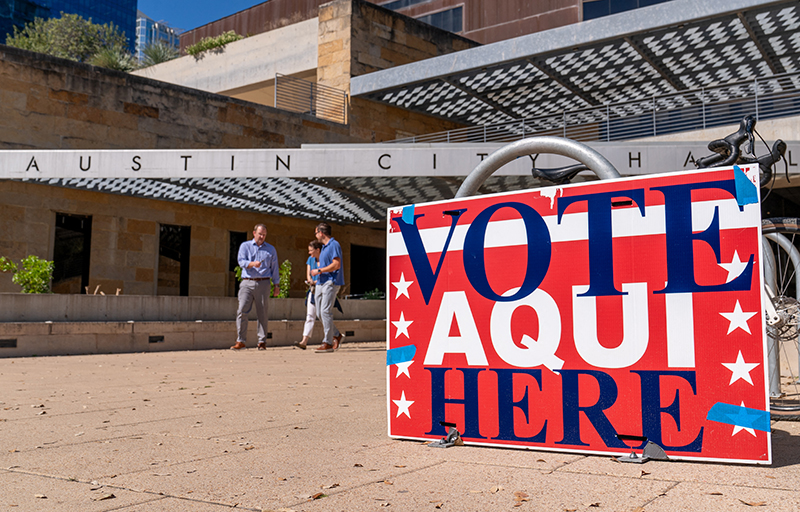AARP Hearing Center
Voter registration: Most U.S. citizens who live in Texas and are at least 18 years old on Election Day can register to vote either by mail or in person.
Voting by mail: A vote-by-mail ballot is available to voters who meet certain qualifications, including those who are 65 or older.
Early voting: All registered voters may vote at an early voting site in their county.
Voting at the polls: Polls are open on Election Day from 7 a.m. to 7 p.m. You must provide an acceptable form of photo ID.
Races we’re watching in 2025
Texas voters will weigh in on 17 constitutional amendments on Tuesday, Nov. 4, including multiple proposals aimed at property tax relief for homeowners and businesses, as well as a ban on state taxes on capital gains. Also on the ballot are propositions to fund water infrastructure and research on dementia treatment, as well as a measure to explicitly prohibit noncitizens from voting.
Bexar County voters will consider two propositions — one to fund a new arena and another to upgrade the Coliseum Complex venue.
Bexar County voters will consider two propositions to increase taxes. One would fund a new arena, and the other would upgrade the Coliseum Complex venue.
In addition, Harris County voters will have a special election for Texas’ 18th Congressional District, while Tarrant County voters have a special election to fill the seat for state Senate District 9.
Houston voters will also choose a candidate for the city council’s at-large Position 4.
Austin voters will consider a tax rate increase.
You can check your county’s elections website to see if there are any local elections where you live.
Below are some key dates for the upcoming general election.
Voter registration:
- Monday, Oct. 6: Deadline to register to vote. Your application to vote by mail must be received by the early voting clerk no later than the 11th day before Election Day (Friday, Oct. 24) by the close of regular business or noon, whichever is later.
In-person voting:
- Monday, Oct. 20 through Friday, Oct. 31: Early voting is available.
- Tuesday, Nov. 4: Election Day. Polls are open 7 a.m. to 7 p.m.
Voting by mail:
- Friday, Oct. 24: Deadline for early voting clerk to receive applications for a vote-by-mail ballot. All applications to vote by mail must be received by the early voting clerk before the close of regular business or noon, whichever is later. Check with your local county’s election office for details.
- Tuesday, Nov. 4: For those eligible to vote by mail, ballots must be received by the early voting clerk by 7 p.m. if the carrier envelope is not postmarked. Vote-by-mail ballots that have been postmarked by 7 p.m. at the location of the election on Election Day will be accepted and counted if they are received by 5 p.m. Wednesday, Nov. 5. You can find your local early voting clerk’s office here.

How to register to vote
The deadline to register to vote or change your voter registration is at least 30 days before the upcoming election date.
On the registration application, you must provide your Texas driver’s license number, Texas personal ID card number or the last four digits of your Social Security number. Or check the box stating you don’t have one of these forms of ID.
You can register:
- By mail: Complete a voter registration application online. Then print, sign and mail it to your county registrar's office. To request an application be mailed to you, contact your county voter registrar.
- In person: Request an application form at your county registrar's office, public libraries and certain government offices.
Registering to vote on Election Day
Texas doesn’t permit registration on Election Day.
Check your voter registration status
Check your registration status via the state’s online voter portal.
How to request a ballot by mail
A vote-by-mail ballot is available to voters who meet certain qualifications, including those who are 65 or older, are sick or have a disability, or will be out of their home county on Election Day and during the early voting period. Applications must be received — not postmarked — by the application deadline, which is the 11th day before Election Day, unless that day falls on a weekend or holiday, in which case the deadline moves to the first preceding business day.
Apply for a ballot:
- By mail: Download an application, fill it in electronically or print and fill it in by hand. Or request an application be mailed to you from the secretary of state’s office or your county’s early voting clerk. Once complete, hand-deliver or mail your application to your county’s early voting clerk. Forms require first-class postage when mailed.
- In person: Request an application from your county’s early voting clerk.
- By email or fax: Download an application, and email the completed form to your county’s early voting clerk, or fax it, if the clerk’s office has a fax machine. You must also mail the original application to the clerk. If applying on or near the deadline, the mailed copy must be received by the clerk no later than the fourth business day after the email or fax version was received.
Your application must include your Texas driver’s license number, Texas personal ID number or election ID certificate number (which is different from your Voter Unique Identifier number). If you haven’t been issued one of these numbers, you can submit the last four digits of your Social Security number.
If you haven’t been issued any of the required personal identification numbers, you can check the box stating so, but your voter’s registration record must not contain any of these numbers.
Returning your ballot by mail
A return envelope will be provided with your ballot. Before sealing your ballot in this envelope, you must include your Texas driver’s license number, Texas personal ID number or election ID certificate number in the space provided. If you haven’t been issued one of these numbers, you can submit the last four digits of your Social Security number, or a statement that you haven’t been issued one of the requested forms of ID.
Return your voted ballot:
- By mail: Mail your ballot to your early voting clerk’s office. To be counted, the clerk must receive your ballot by the close of polls on Election Day if your ballot is not postmarked. If your ballot is postmarked by 7 p.m. on Election Day, it must arrive no later than 5 p.m. on the day after Election Day, unless that day is a Saturday, Sunday or legal state or national holiday, in which case the deadline is extended to the next regular business day.
- In person: Deliver your ballot to your early voting clerk’s office on Election Day by 7 p.m.
Check the status of your mail-in ballot via the state’s online Ballot by Mail Tracker.
Voting in person before Election Day
Any eligible registered voter can cast a ballot at an early voting site in their county.
In-person early voting generally begins the 17th day before Election Day — unless that day is on a weekend, in which case early voting starts on Monday — and ends the 4th day before Election Day. However, for some special elections and for elections held in May, it starts the 12th day before Election Day and ends on the 4th day before Election Day.
Hours vary by location. For location details, check with your county elections office or the state’s online voter portal.
Voting at the polls on Election Day
Poll hours are 7 a.m. to 7 p.m. local time. If your county participates in the Countywide Polling Place Program, you can vote at any location in your county. If your county doesn’t participate, you can only vote at the voting precinct assigned to you.
Find your voting precinct location using the state’s My Voter Portal, which will be populated with voting sites closer to Election Day, or contact your county elections office. Your voting precinct number (Pct. No.) is located next to your birth year on your voter registration certificate.
Voter ID requirements on Election Day
Before voting, you must present one of Texas’ seven acceptable forms of photo ID, which include a Texas driver’s license, an election identification certificate and a U.S. passport.
If you don’t have a photo ID and can’t reasonably obtain one, you can fill out a Reasonable Impediment Declaration at your polling place. You must also present an acceptable form of supporting ID, such as a current utility bill or bank statement.
If you have an acceptable photo ID but didn’t bring it to your polling place, you can still vote a provisional ballot. For your vote to count, you must present an acceptable ID to your county registrar within six days or process an exemption if it was lost in a natural disaster.
Voting with a disability
Voters who are sick or have a disability may request a vote-by-mail ballot.
All polling places in the state must be accessible for voters. Voters who can't read English may use interpreters at the polls. If a voter is physically unable to enter a polling place, curbside voting is available. If planning to vote curbside, you’re encouraged to call your polling place ahead of arrival.
If you need assistance to cast your ballot, you may ask a person of your choosing (aside from your employer, an agent of your employer, or an officer or agent of your union) or two election workers. The person assisting must recite an oath stating they’ll mark the ballot as directed and won’t try to influence the voter. For more information, visit votetexas.gov.
Editor’s note: This guide was originally published Sep. 8, 2023. It has been updated with new information for 2025 elections.































































